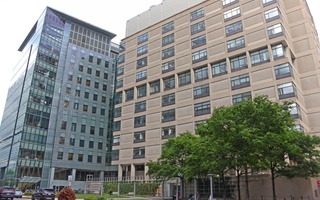{shortcode-d1b742ff8e7dab8f81d3b04c799a6bdfee367e40}Harvard Medical School is hosting a series of diversity-focused dialogues this year to address racial inclusion at the school and the racial makeup of its students and faculty.
The recently released final report of the University-wide Presidential Task Force on Inclusion and Belonging revealed that the Medical School has the lowest percentage of underrepresented minority faculty across all of Harvard’s schools.
Multiple school administrators, including Dean of the Medical School George Q. Daley ’82 and Dean for Diversity and Community Partnership Joan Y. Reede, have attended the dialogues alongside faculty, students, and staff.
The first dialogue, held earlier this year in the Waterhouse Room in Gordon Hall, focused on public images and art at the school.
“You walk down the halls of Harvard Medical School, and all of the portraiture is 1700s and 1800s white guys,” Daley said. “There in the Waterhouse Room, we've got this series of portraits from our founders and from past deans, and then we have a few photographs of women faculty, prominent women faculty, photographs of prominent African-American faculty.”
Reede said students shared a range of experiences with public images at the event. Some students “very much feel left out,” while others do not notice the lack of women or people of color in public art, according to Reede.
“It runs the full gamut,” she said.
Public art and imagery have come up in other diversity-related discussions at the Medical School and the University.
A subcommittee of the Dean’s Diversity Task Force, established last year, will be looking into campus representations of prominent alumni and former faculty and giving recommendations to Daley about the matter.
Advocacy group White Coats for Black Lives,which gave Harvard Medical School a B- on racial justice last week, wrote in its report card that the school’s “physical space explicitly celebrates racist/white supremacist individuals.”
“The overwhelming majority of individuals whose likenesses are present in Harvard Medical School public spaces are white men,” the group’s report stated.
Inclusive symbols and spaces are also among the goals outlined in the Presidential Task Force on Inclusion and Belonging final report. The task force comprised 55 members from across the University, including HMS Professor of Clinical Medicine Katrina A. Armstrong.
The second dialogue, held last week, discussed “being other,” which Reede said is an experience “the vast majority of people” have experienced.
“The messages that came out of that I think really illuminated the nature of the kinds of values we want to aspire to at Harvard Medical School,” Daley said. “And that is a community where every individual is valued, every individual is supported and can rise to the level of their bravest aspirations.”
The next dialogue will focus on microaggressions, according to Reede.
—Staff writer Luke W. Vrotsos can be reached at luke.vrotsos@thecrimson.com. Follow him on Twitter at luke_vrotsos.

















